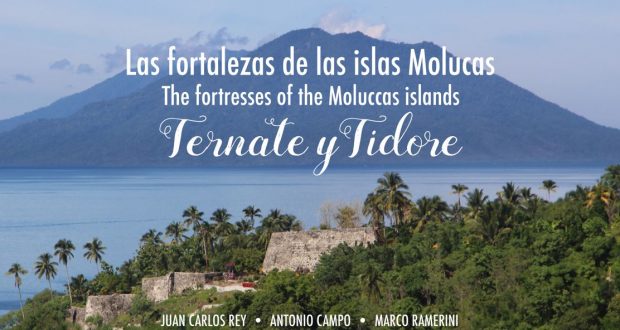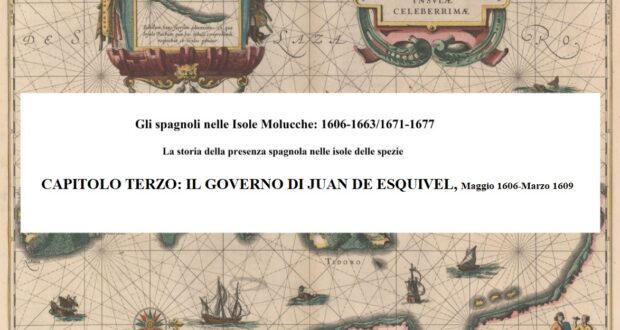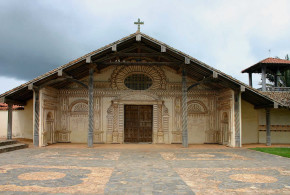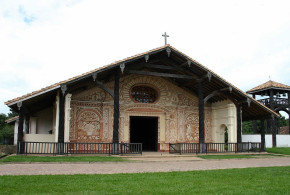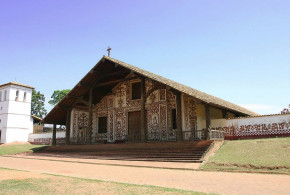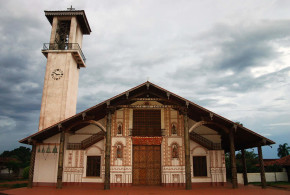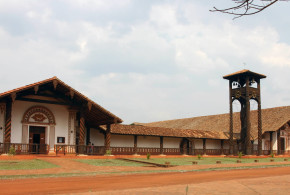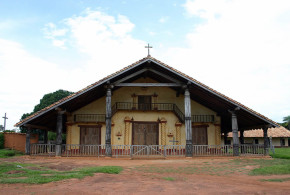Written by Marco Ramerini. Photos by Geoffrey A. P. Groesbeck San Javier is a small town in the department of Beni in the Amazonian plains of the State of Bolivia. The city lies at an altitude of 537 metres between the Rio Paquius and the Río San Julián. The town of Concepcion is located 60 km north-east, while the city of Santa ...
Read More »San Rafael de Velasco Mission: Jesuit Missions of Chiquitos (Eastern Bolivia)
Written by Marco Ramerini. Photos by Geoffrey A. P. Groesbeck This mission is located in the town of San Rafael de Velasco which is located in Eastern Bolivia, about 40 km east of the city of San Miguel de Velasco and approximately 470 km north-east of the city of Santa Cruz de la Sierra. The city lies at an altitude of 408 meters in the ...
Read More »San Miguel de Velasco Mission: Jesuit Missions of Chiquitos (Eastern Bolivia)
Written by Marco Ramerini. Photos by Geoffrey A. P. Groesbeck This mission is located in the town of San Miguel de Velasco which is located in Eastern Bolivia, about 30 km south of the city of San Ignacio de Velasco. The city lies at an altitude of 485 meters in the region of Chiquitanía, an unspoilt area of Bolivia between the cities of Santa ...
Read More »San Ignacio de Velasco Mission: Jesuit Missions of Chiquitos (Eastern Bolivia)
Written by Marco Ramerini. Photos by Geoffrey A. P. Groesbeck This mission is located in the town of San Ignacio de Velasco which is located in Eastern Bolivia, about 480 kilometers north-east of the city of Santa Cruz de la Sierra on a hill near the headwaters of the river Paragua. The town is located at a height of 410 meters on the banks ...
Read More »Concepción Mission: Jesuit Missions of Chiquitos (Eastern Bolivia)
Written by Marco Ramerini. Photos by Geoffrey A. P. Groesbeck This mission is located in the town of Concepción which is located in Eastern Bolivia, about 280 km north-east of the city of Santa Cruz de la Sierra. The mission of Concepción was founded in 1699 by the Jesuits Fr. Francisco Lucas Caballero and Fr. Francisco Herbás. A few years after its foundation, ...
Read More »Who Constructed the Mission Churches? Jesuit Missions of Chiquitos (Bolivia)
Evanescence and Permanence: Toward an Accurate Understanding of the Legacy of the Jesuit Missions of Chiquitos. Written by Geoffrey A. P. Groesbeck – Part 2: How Many Jesuit Missions Were Founded? Who Constructed the Mission Churches? Another often-repeated error is that the first permanent (not provisional) churches of the mission complexes, or conjuntos misionales, of the Jesuit missions in the ...
Read More »Jesuit Missions of Chiquitos (Eastern Bolivia)
Evanescence and Permanence: Toward an Accurate Understanding of the Legacy of the Jesuit Missions of Chiquitos. Written by Geoffrey A. P. Groesbeck This article and its companion piece, “The Long Silence: The Jesuit Missions of Chiquitos after the Extrañamiento”, are two halves of a whole, written primarily to remedy the fact that no accurate historical overview of the twelve Jesuit ...
Read More »The forts of Salvador (Bahia)
Written by Marco Ramerini. English text revision by Dietrich Köster. Right from the founding of the city the Portuguese started with the construction of a defensive system against foreign invasions, which occurred until the 18th century. The main works of fortification were executed after the Dutch conquest of the town (1624-1625) and the successive reconquest by the Portuguese. Fearing another ...
Read More »Salvador (Bahia): the capital of Colonial Brazil
Written by Marco Ramerini. English text revision by Dietrich Köster. The Florentine Amerigo Vespucci, on 1 January 1502, came to a gulf at 13° latitude south, to which he gave the name Bahia de Todos Santos, on the shores of which the city of Bahia now stands. Salvador was founded in 1549 by Tomé de Souza, the first governor-general of ...
Read More »Recife Forts: Fort do Brum, Fort das Cinco Pontas
Written by Marco Ramerini. English text revision by Dietrich Köster. FORTE DO BRUM One of the most important remains of the Dutch rule in northeast Brazil is the Forte do Brum (Fort de Bruyne), on the northern end of Recife island. The fort was originally started to built in 1629 by the Portuguese, when the Dutch took control of Pernambuco ...
Read More »Recife: the capital of sugar cane of Colonial Brazil
Written by Marco Ramerini. English text revision by Dietrich Köster. Recife is now the capital of the Brazilian state of Pernambuco. Until the 17th century the city was a small village near the capital of the Capitania of Pernambuco, Olinda. In 1630 with the Dutch conquest of northeastern Brazil, Olinda was burned by the Dutch, just because it was considered ...
Read More »Governors and Viceroys of Portuguese Brazil, 1549-1760
Written by Marco Ramerini. Brazil was discovered, almost by accident in 1500 by a Portuguese expedition live in the East under the command of Pedro Alvares Cabral. Cabral ‘s expedition followed the sea route to India traveled recently by Vasco da Gama, sailing around Africa. The expedition – to avoid the equatorial calms – followed a route far from the African coast ...
Read More »Fort Orange (Oranje), Itamaracá: a Dutch fortress in Brazil
Written by Marco Ramerini. English text revision by Dietrich Köster. Fort Orange is situated 60 km north of Recife (Pernambuco). In this area the Portuguese founded a trading factory (feitoria) in 1516. On 1 September 1534 the King of Portugal created the “capitania” of Itamaracá. It was given to the donatarian Pero Lopez de Sousa. This “capitania” extended over 30 ...
Read More »Olinda: a UNESCO World Heritage site in Brazil
Written by Marco Ramerini. English text revision by Dietrich Köster. The city of Olinda, which is located a few kilometers north of Recife, was founded by the Portuguese in 1535 and was one of the first settlements founded by Europeans in Brazil. At the beginning of the 17th century the city became the capital of the capitania of Pernambuco, but ...
Read More »Igarassu: the oldest Church of Brazil
Written by Marco Ramerini. English text revision by Dietrich Köster. Igarassu (Igaraçu) is a beautiful little village situated 30 km north of Recife. In 1535 the Portuguese Duarte Coelho landed on this place to occupy his captaincy, donated by the Portuguese Crown. Duarte Coelho installed a stone mark, functioning as a dividing spot between the captaincies of Pernambuco and Itamaracá. This ...
Read More »Paraty a Colonial Town in the state of Rio de Janeiro
Written by Marco Ramerini. English text revision by Dietrich Köster. The main attraction of Paraty is its historic center with beautifully preserved colonial architecture. It is a day trip from the city of Rio de Janeiro. The distance is 240 km and it takes 4 hours to reach Paraty with a car along the beautiful coast of the Costa Verde, ...
Read More »The Dutch in Brazil
Written by Marco Ramerini. English text revision by Dietrich Köster. THE AMAZON SETTLEMENTS In 1600, according to Ioannes De Laet, the Dutch possessed two wooden forts (Fort Nassau and Fort Oranje) on the eastern shore of the Xingu River. These had been built by colonists from Zeeland. In 1616, a Zeeland expedition under the command of Pieter Adriaenszoon Ita sailed ...
Read More »The French in Brazil: Saint-Alexis, France Antarctique (Rio de Janeiro), Ipiapaba and Sao Luís do Maranhão
Written by Marco Ramerini. English text revision by Dietrich Köster. The French ports of Normandy, especially Rouen and Dieppe, had a flourishing textile industry and thus became the principal competitors in trade for Portugal in Brazil in the 16th century. Due to the presence of vast forests of “Pau Brasil” on the Brazilian coast (used in the process of cloth ...
Read More »Dutch in Chile: Hendrick Brouwer’s expedition to Valdivia
Written by Robbert Kock. English text revision by Dietrich Köster. Since the Spaniards arrived in Chile in 1535, Valdivia was one of the first cities, which the Spanish colonists founded. The city, founded in 1552, was named after the Spanish explorer Pedro de Valdivia. He became the first governor of Chile from 1541 till 1553. The main reason for the ...
Read More »New Sweden: The Swedish settlements in North America
Written by Marco Ramerini. English text revision by Dietrich Köster. The King of Sweden as early as 1624, encouraged by Willem Usselinx, was planning an expedition to North America, but the Thirty Years’ War stopped his plans. In 1632 the Walloon, a former Governor of Dutch New Netherland, Peter Minuit offered his services to Sweden. He planned to establish a ...
Read More » Colonial Voyage The website dedicated to the Colonial History
Colonial Voyage The website dedicated to the Colonial History
